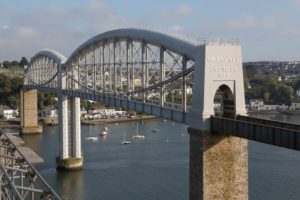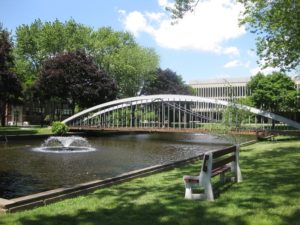Wrought iron bridges are some of the most impressive in the world, with the most famous structures designed by illustrious civil engineers in the 19th century. Here is our pick of the most impressive true wrought iron bridges on the planet.
Wrought iron bridges from history
1. Royal Albert Bridge

The famous Royal Albert Bridge is a truss bridge named after Prince Albert, who opened it in 1856. It was designed by the legendary civil engineer Isambard Kingdom Brunel, considered to be one of the most ingenious and prolific figures in engineering history. It’s gorgeous curved lines and tubular beams make it one of the most eye-catching bridges in Britain, where it spans the River Tamar in Plymouth.
The bridge spans an impressive 666 metres in total, with a road width of around 5 metres. It has 455 trusses, which at the time, made it by far the biggest bridge of its type. Today, the bridge allows commuter trains to cross the river from the western Saltash to the eastern city of Plymouth.
2. Garabit Viaduct

This gorgeous wrought iron bridge can be found spanning the Truyère river in the south of France. It was designed by Gustave Eiffel (or Eiffel Tower fame) in around 1880, as a way to carry rail traffic across the river. It’s colossal parabolic truss-arch, momentous supports, and strawberry-coloured paint make it an impressive sight against the French countryside.
In 1882, this bridge gave France the title of “the world’s three highest bridges,” which became the envy of other civil engineers trying to outdo each other. This bridge stands at an impressive height of 124 meters, roughly the same as The Great Pyramid of Giza.
3. Hohenzollern Bridge (Cathedral Bridge)

Hohenzollern Bridge is a railway and street bridge that crosses the Rhine in Cologne, Germany. It’s an arched truss bridge with a span of 409 metres, joining Cologne’s Main Station and Koelnmesse on the other side.
This bridge was designed by Hermann Lohse and Friedrich Wilhelm Wallbaum, and was completed in 1859 after four years of construction. Lohse is responsible for the bridge’s gorgeous wrought iron latticework, which criss-crossed over the entire structure.
4. John A. Roebling Suspension Bridge

This impressive electric blue suspension bridge can be found in the city of Cincinnati, and at the time of its opening in 1866, was the longest suspension bridge in the world, running 322 metres across the Ohio River. The bridge is named after its designer—John Roebling—who more famously built the Brooklyn Bridge in New York.
The bridge’s construction was halted by the onset of the US Civil War, which later provided motivation to complete it as a reliable way to cross the river for troops. Today, it serves as a main road for the city, and also allows residents to get between major sports venues, hotels, bars, and other culturally important areas of the city.
5. Moseley Wrought Iron Arch Bridge

Image from Elizabeth Thomsen
This pretty arch bridge can be found on the Merrimack College campus in Massachusetts. It was originally located in the city of Lawrence, completed in 1864 as a way to connect industrial mills and printworks to the town centre on the other side. But it partially collapsed in late 1980 and was taken apart and rebuilt by civil engineering students, who now use it as a walking bridge.
The bridge has a 29-metre span (the distance between its supports), and is a nice example of a wrought iron arch bridge.
Bridges are one of the many things made of iron that are indispensable to us, and skilled engineers, architects, and construction workers have blessed us with stunning wrought iron bridges that still stand strong today.
- Location
- Build date
- Type
- Height
- Purpose

